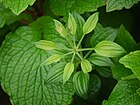Note: This is a project under development. The articles on this wiki are just being initiated and broadly incomplete. You can Help creating new pages.
Difference between revisions of "Rubia cordifolia - Manjishtha"
(→Uses) |
|||
| Line 4: | Line 4: | ||
==Uses== | ==Uses== | ||
| − | {{Uses|Uterine bleeding}}, {{Uses|Internal and external haemorrhage}}, {{Uses| | + | {{Uses|Uterine bleeding}}, {{Uses|Internal and external haemorrhage}}, {{Uses|Bronchitis}}, {{Uses|Rheumatism}}, {{Uses|Stones in the kidney}}, {{Uses|Blotches}}, {{Uses|Bladder and gall}}, {{Uses|Dysentery}}, {{Uses|Febrifuge}} |
==Parts Used== | ==Parts Used== | ||
Revision as of 11:39, 25 December 2019
Manjishtha is a species of flowering plant in the coffee family. It has been cultivated for a red pigment derived from roots.
Contents
- 1 Uses
- 2 Parts Used
- 3 Chemical Composition
- 4 Common names
- 5 Properties
- 6 Habit
- 7 Identification
- 8 List of Ayurvedic medicine in which the herb is used
- 9 Where to get the saplings
- 10 Mode of Propagation
- 11 How to plant/cultivate
- 12 Commonly seen growing in areas
- 13 Photo Gallery
- 14 References
- 15 External Links
Uses
Uterine bleeding, Internal and external haemorrhage, Bronchitis, Rheumatism, Stones in the kidney, Blotches, Bladder and gall, Dysentery, Febrifuge
Parts Used
Chemical Composition
Hydroxy-3-ethyl, anthraquinone, dihydroxy, pentyl-naphthaquinonyl, phenanthrene[1]
Common names
| Language | Common name |
|---|---|
| Kannada | Chitravalli, Manjista |
| Hindi | Majith |
| Malayalam | Chovvallikkoti, Man-chetti |
| Tamil | Manjitti, Sevvelli |
| Telugu | Chiranji, Manjishta |
| Marathi | NA |
| Gujarathi | NA |
| Punjabi | NA |
| Kashmiri | NA |
| Sanskrit | Aruna, Asra |
| English | Indian Madder, Common Madder |
Properties
Reference: Dravya - Substance, Rasa - Taste, Guna - Qualities, Veerya - Potency, Vipaka - Post-digesion effect, Karma - Pharmacological activity, Prabhava - Therepeutics.
Dravya
Rasa
Tikta (Bitter), Kashaya (Astringent)
Guna
Laghu (Light), Ruksha (Dry), Tikshna (Sharp)
Veerya
Ushna (Hot)
Vipaka
Katu (Pungent)
Karma
Kapha, Vata
Prabhava
Habit
Identification
Leaf
| Kind | Shape | Feature |
|---|---|---|
| Simple | Ovate | The evergreen leaves are 5-10 cm long and 2-3 cm broad, produced in whorls of 4-7 starlike around the central stem |
Flower
| Type | Size | Color and composition | Stamen | More information |
|---|---|---|---|---|
| Unisexual | 3-5 mm | Yellow | 5-20 | The flowers are small, with five greenish yellow or pale yellow petals, in dense racemes |
Fruit
| Type | Size | Mass | Appearance | Seeds | More information |
|---|---|---|---|---|---|
| black berry | 4-6 mm | clearly grooved lengthwise, Lowest hooked hairs aligned towards crown | With hooked hairs | many | {{{6}}} |
Other features
List of Ayurvedic medicine in which the herb is used
Where to get the saplings
Mode of Propagation
Seeds, Two node root cuttings.
How to plant/cultivate
The plant is propagated through seeds and two-node root cuttings. The seeds are collected during December and January. The seeds obtained from dried ripe black fruits are sown in nursery beds either in rows or randomly by broadcasting. A thin layer of soil and organic manure is spread over the seeds, and the beds are regularly watered.[4]
Commonly seen growing in areas
Forest edges, Evergreen forest, Rocky areas.
Photo Gallery
References
External Links
- Ayurvedic Herbs known to be helpful to treat Uterine bleeding
- Ayurvedic Herbs known to be helpful to treat Internal and external haemorrhage
- Ayurvedic Herbs known to be helpful to treat Bronchitis
- Ayurvedic Herbs known to be helpful to treat Rheumatism
- Ayurvedic Herbs known to be helpful to treat Stones in the kidney
- Ayurvedic Herbs known to be helpful to treat Blotches
- Ayurvedic Herbs known to be helpful to treat Bladder and gall
- Ayurvedic Herbs known to be helpful to treat Dysentery
- Ayurvedic Herbs known to be helpful to treat Febrifuge
- Herbs with Leaves used in medicine
- Herbs with Fruits used in medicine
- Herbs with common name in Kannada
- Herbs with common name in Hindi
- Herbs with common name in Malayalam
- Herbs with common name in Tamil
- Herbs with common name in Telugu
- Herbs with common name in Sanskrit
- Herbs with common name in English
- Habit - Perennial plant
- Index of Plants which can be propagated by Seeds
- Index of Plants which can be propagated by Two node root cuttings
- Herbs that are commonly seen in the region of Forest edges
- Herbs that are commonly seen in the region of Evergreen forest
- Herbs that are commonly seen in the region of Rocky areas
- Herbs
- Ayurvedic herbs that don't have seed photos
- Rubiaceae




